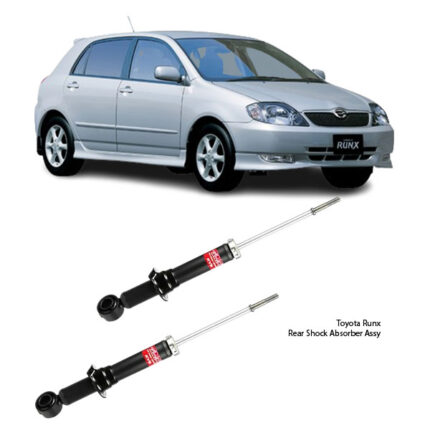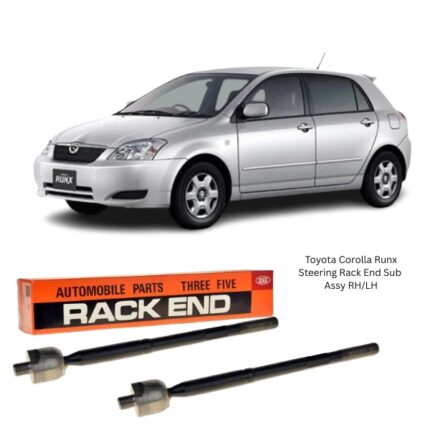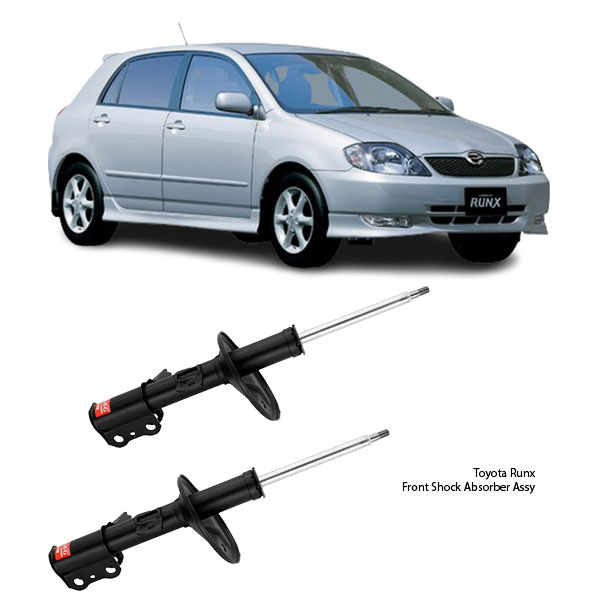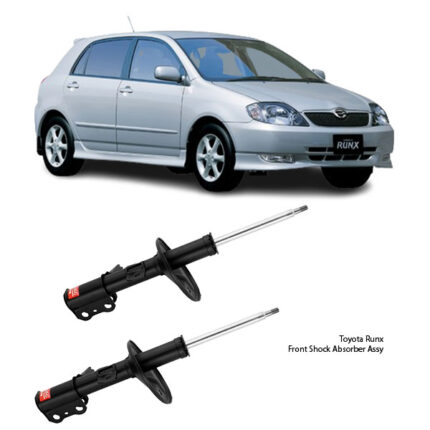-7%
Get Toyota Corolla Runx /Allex Front shock Absorber Assy 334323 / 334324 in Kenya
When you hit a bump or make a quick turn and your car stays steady without bouncing or swaying, it’s not just good luck — it’s the front shock absorber assembly doing its job.
Though hidden beneath the body of your car, this critical component plays a vital role in how your vehicle handles, brakes, and rides. Without it, your driving experience would be uncomfortable, unsafe, and unpredictable.
Let’s dive into what makes the front shock absorber assembly so important and why replacing it on time ensures the safety, comfort, and performance of your vehicle.
What Is a Front Shock Absorber Assembly?
The front shock absorber assembly is part of your vehicle’s front suspension system. It’s designed to absorb and dampen shock impulses, helping to control the up-and-down movement of your front wheels when driving over rough or uneven surfaces.
This assembly typically includes:
The shock absorber (hydraulic or gas-based)
Mounting hardware (bushings, bolts, nuts)
A dust boot to protect it from dirt and debris
Sometimes a coil spring seat for strut-based systems
Its main job? To keep your tyres in contact with the road, absorb the energy from bumps, and control suspension movement.
How Does It Work?
When your car encounters a bump, the wheel rises to absorb the impact. The shock absorber inside the assembly slows down this movement by forcing hydraulic fluid (or gas) through small internal valves.
This damping effect transforms kinetic energy (motion) into thermal energy (heat), preventing your car from bouncing uncontrollably.
Core Components:
Piston & Rod – Moves inside a sealed chamber
Hydraulic Oil or Gas – Provides resistance
Valving System – Controls fluid flow and dampening strength
Upper & Lower Mounts – Connect to vehicle’s chassis and control arms
Dust Shield – Guards against wear and corrosion
Why Are Front Shocks So Important?
Unlike the rear, the front suspension bears the brunt of road feedback. The front end supports a heavier load (engine weight), absorbs the impact of steering maneuvers, and plays a critical role during braking, cornering, and accelerating.
With good front shocks, you get:
Smooth and stable rides
Controlled steering and turning
Reduced nose-diving under braking
Even tyre wear and longer tyre life
Protection for other components (like control arms and struts)
Your safety and comfort depend heavily on your front shock absorber assembly.
How to Know It’s Time to Replace Front Shocks
Shock absorbers degrade slowly, so it can be hard to notice the change. But over time, their effectiveness diminishes — and your vehicle’s performance follows.
Signs of worn front shock absorbers include:
Excessive bouncing after hitting bumps
Steering feels loose or unstable
Longer braking distances
Nose-diving when braking
Uneven front tyre wear
Clunking or knocking sounds over rough roads
Fluid leakage around the shock body
Any of these symptoms can mean your front shocks are failing — and it’s time for inspection or replacement.
When Should Front Shocks Be Replaced?
As a rule of thumb, front shocks should be checked every 20,000 km and typically replaced around 60,000 to 100,000 km, depending on your driving style and road conditions.
Factors that affect shock life:
Driving on rough or unpaved roads
Carrying heavy loads frequently
Aggressive driving habits
Type and quality of shock absorbers
Routine maintenance saves you from expensive suspension repairs later.
Front Shock Absorber Assy vs. Front Strut – What’s the Difference?
Many people confuse shock absorbers with struts, and though both dampen suspension movement, they’re not the same.
| Feature | Shock Absorber Assembly | Strut Assembly |
|---|---|---|
| Function | Damping only | Structural + damping |
| Components | Shock, bushings, bolts | Shock, coil spring, mount |
| Complexity | Easier to replace | More complex and costly |
| Location | Often rear or front (trucks/SUVs) | Common in front of cars |
Some vehicles use struts in the front and shocks in the rear, while others use shocks all around. Always check your vehicle’s setup.
Benefits of Replacing Front Shocks On Time
Still wondering why it matters? Timely replacement of front shock absorber assemblies brings:
Improved vehicle stability
Better braking response
Enhanced tyre traction
Less wear on suspension joints
Increased driving comfort
Reduced cabin vibrations and noise
And perhaps most importantly — peace of mind every time you hit the road.
Front Shock Replacement – The Basic Process
Replacing a front shock is a job best left to a professional technician. Here’s an overview of the steps involved:
-
Lift the vehicle and remove the front wheels
-
Unbolt the old shock from the upper and lower mounts
-
Inspect mounts and bushings for damage
-
Install the new shock using manufacturer-specified torque
-
Reassemble components and perform a test drive
Pro tip: Always replace front shocks in pairs (left & right) to maintain balanced handling.
Follow us on Facebook for more parts.




